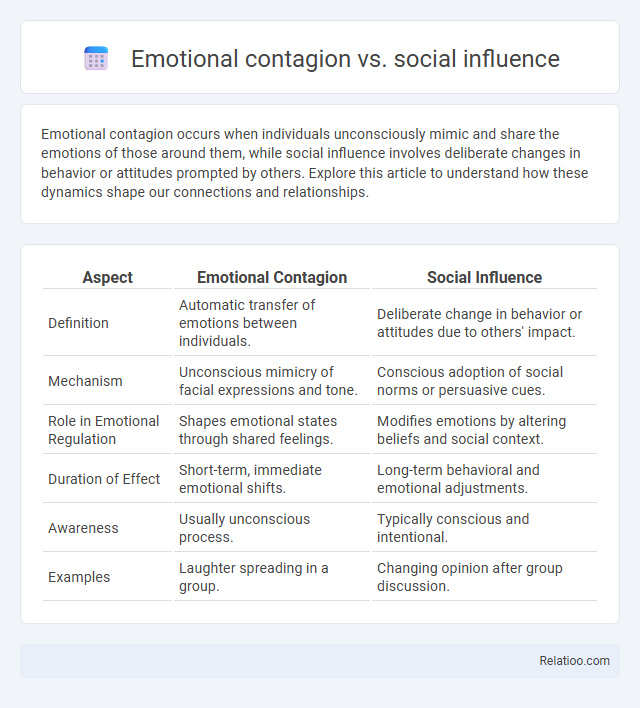Emotional contagion occurs when individuals unconsciously mimic and share the emotions of those around them, while social influence involves deliberate changes in behavior or attitudes prompted by others. Explore this article to understand how these dynamics shape our connections and relationships.
Table of Comparison
| Aspect | Emotional Contagion | Social Influence |
|---|---|---|
| Definition | Automatic transfer of emotions between individuals. | Deliberate change in behavior or attitudes due to others' impact. |
| Mechanism | Unconscious mimicry of facial expressions and tone. | Conscious adoption of social norms or persuasive cues. |
| Role in Emotional Regulation | Shapes emotional states through shared feelings. | Modifies emotions by altering beliefs and social context. |
| Duration of Effect | Short-term, immediate emotional shifts. | Long-term behavioral and emotional adjustments. |
| Awareness | Usually unconscious process. | Typically conscious and intentional. |
| Examples | Laughter spreading in a group. | Changing opinion after group discussion. |
Introduction to Emotional Contagion and Social Influence
Emotional contagion refers to the automatic and unconscious transmission of emotions between individuals through mimicry and synchronization of facial expressions, vocalizations, and postures, which leads to shared emotional experiences. Social influence encompasses broader behavioral and attitudinal changes in individuals, driven by the presence, actions, or opinions of others, including conformity, compliance, and obedience mechanisms. While emotional contagion specifically targets the spread of emotions, social influence incorporates both emotional and cognitive processes affecting individual and group behavior.
Defining Emotional Contagion
Emotional contagion refers to the automatic and unconscious transfer of emotions from one person to another through nonverbal cues like facial expressions, tone of voice, and body language. Unlike social influence, which involves deliberate persuasion or behavioral change based on attitudes and beliefs, emotional contagion occurs spontaneously and shapes group mood and interpersonal dynamics. Understanding emotional contagion is crucial in contexts such as workplace environments, where shared emotional states impact team cohesion and productivity.
Understanding Social Influence
Understanding social influence involves examining how individuals' thoughts, feelings, and behaviors are shaped by others in a social context. Unlike emotional contagion, which specifically refers to the automatic transmission of emotions between people, social influence encompasses broader processes such as conformity, compliance, and persuasion that affect attitudes and decisions. Studying the mechanisms of social influence is essential for fields like psychology, marketing, and organizational behavior to effectively predict and guide human interactions.
Key Differences Between Emotional Contagion and Social Influence
Emotional contagion involves the automatic spread of emotions between individuals through nonverbal cues like facial expressions and tone of voice, whereas social influence encompasses deliberate efforts to change attitudes or behaviors through persuasion or social norms. You experience emotional contagion passively as feelings transfer unconsciously, while social influence requires active cognitive processing of information and social context. The key difference lies in emotional contagion's immediate, often unconscious emotional transmission versus social influence's intentional shaping of beliefs and actions over time.
Mechanisms Behind Emotional Contagion
Emotional contagion operates through automatic mimicry and synchronization of expressions, vocalizations, and postures, triggering shared emotional experiences among individuals. This mechanism primarily relies on mirror neuron systems and affective empathy, enabling unconscious emotional alignment without deliberate social persuasion. In contrast, social influence involves intentional cognitive processes such as conformity, compliance, and persuasion, which depend on social norms and interpersonal communication rather than automatic emotional transfer.
How Social Influence Operates
Social influence operates by shaping individual attitudes and behaviors through conformity, compliance, and obedience within social contexts, often driven by perceived norms and group dynamics. Unlike emotional contagion, which involves the automatic transfer of emotions through nonverbal cues, social influence relies on cognitive processes where individuals consciously or unconsciously adjust their beliefs and actions to align with others. This mechanism plays a critical role in decision-making, social learning, and group cohesion, impacting everything from everyday interactions to large-scale social movements.
Real-World Examples: Emotional Contagion vs Social Influence
Emotional contagion occurs when individuals unconsciously mimic and synchronize emotions with others, as seen in workplaces where positive mood spreads through team interactions, boosting overall morale and productivity. Social influence involves deliberate changes in behavior or attitudes due to group pressure or persuasion, exemplified by consumer trends shaped by celebrity endorsements or peer recommendations. Real-world examples include crowds at sports events exhibiting emotional contagion through shared excitement, while social influence drives voting behaviors during elections through targeted campaigns and social networks.
Impact on Group Behavior and Dynamics
Emotional contagion triggers rapid, automatic spread of feelings within groups, shaping collective mood and fostering empathy or tension. Social influence involves intentional persuasion and norm enforcement, guiding group decisions and behavior change through perceived authority or peer pressure. Your awareness of these dynamics enhances group cohesion by balancing spontaneous emotional resonance with deliberate behavioral adjustments.
Practical Implications in Everyday Life
Emotional contagion drives how moods and emotions spread rapidly within groups, affecting workplace morale and team productivity through unconscious mimicry of expressions and tone. Social influence shapes decision-making and behavior more broadly by leveraging norms, peer pressure, and authority, often guiding consumer choices and compliance with social rules. Understanding these mechanisms enables individuals and leaders to foster positive environments by promoting supportive interactions and mitigating negative emotional spillover, crucial for mental health and effective communication.
Conclusion: Navigating Emotional Contagion and Social Influence
Emotional contagion and social influence operate through interconnected yet distinct psychological mechanisms, with emotional contagion involving the automatic transmission of emotions and social influence encompassing deliberate behavioral changes based on social norms or pressures. Effectively navigating these phenomena requires heightened self-awareness and emotional regulation to discern between involuntary emotional absorption and conscious social adaptation. Mastery of this balance enables healthier interpersonal dynamics and resilience against negative emotional escalation within social environments.

Infographic: Emotional contagion vs Social influence
 relatioo.com
relatioo.com